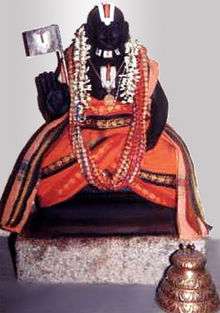Yamunacharya
Yamunacharya also known as Alavandar and Periya Mudaliar[1] was a Vishistadvaita philosopher in Srirangam, Tamil Nadu, India. Ramanuja, one of the leaders of the srivaishnava school sought to be his disciple. He was born in early 10th century CE and was the grandson of a Brahmin, Nathamuni.[2] Nathamuni was a famed yogi who collected the works of Tamil alvars.
| Part of a series on |
| Vaishnavism |
|---|
 |
|
Holy scriptures
|
|
Sampradayas
|
|
Related traditions |
|
|
Yamunacharya(Alavandar) | |
|---|---|
 Yamunacharya(Alavandar), Acharya of Sri Vaishnava sampradaya & the predecessor of Ramanuja | |
| Personal | |
| Born | Srirangam, Tamil Nadu, India |
| Died | Srirangam |
| Religion | Hinduism |
| Philosophy | Vishistadvaita |
Alavandar's birth star was Uttiradam.
Early life
| Part of a series on | |
| Hindu philosophy | |
|---|---|
 | |
| Orthodox | |
|
|
|
| Heterodox | |
|
|
|
|
|
|
He grew up learning Vedic texts from Rama Misra also known as Manakkal Nambi and was skilled in mimansa. SriVaishnavite legend relates this history—As a teenager he challenged the royal priest Akkiyalvan of the Pandya king (the name of the king is disputed). Akkiyalvan, when he saw the age of the youth, asked sarcastically "alavandara?" meaning "has he come to rule me?". He defeated Akkiyalvan by proving through the accepted rules of logic that Akkiyalvan's mother was barren, the king was not righteous and the queen unchaste. The king and queen, impressed that the boy has understood the shortcomings of logic, adopted him.The queen hailed the boy as "Alavandhaar"- the saviour. In other versions of the legend, he is given half the kingdom. There is no historical record to show his reign so it is possible that this happened in a smaller village rather than the kingdom of Pandya.[3]
After years of rule, Mannakal Nambi tricked him into visiting the temple of Ranganatha. There, he had an epiphany and gave up the material duties of a king and became a sanyasin embracing saranagati. He composed the chatushloki and Strotra Ratna at that spot. Mannakal Nambi handed over the reins of Natha Muni's school including the collected Divya Prabandha and renamed him Yamuna Muni or Yamunacharya.
After the demise of Alavandar, Srirangam was led by the latter's son Thiruvarangan, however the place lacked the divine touch. According to a legend, Lord Ranganatha himself instructed Mahapurna to go to Kanchi and invite Ramanuja to Srirangam.[4]
- The names of Parashara and Veda Vyasa, should be commemorated on the earth by giving it to a person worthy to bear it.
- Compose a commentary on Tiruvaymozhi of Nammalvar the most prolific of Alvars.
- Compose a commentary on Upanishads, Vedanta Sutras and Bhagavad Gita.
Works
Alavandar, like Ramanuja, focused both on philosophical debates like dvaita vs. advaita and bhakti prayers and the works attributed to him are in Sanskrit although he codified the heritage of the Tamil Alvars. Works attributed to him are:
- Chathusloki - a popular prayer in praise of Lakshmi
- Stotraratnam - a prayer in praise of Narayana
- Siddhitrayam - consisting of (i) Atmasiddhi. (ii) Samvitsiddhi and (iii) Iswarasiddhi which describe the Vishistadvaita school of thought, describing a relation between the soul, god and the universe
- Agama Pramanya - stating the authority of Pancharatra agama
- Maha Purusha Nirnayam - describing that the ultimate reality is the god-goddess pair Sri and Narayana
- Gitartha Sangraha - a commentary on the Bhagvad Gita
- Nityam
- Mayavada Khandanam
References
- "Details of Sri Vaishnavism, Guru Krupa Foundation" (PDF). http://guru-krupa.org. Retrieved 7 November 2018. External link in
|website=(help) - Jones, Constance (2007). Encyclopedia of Hinduism. New York: Infobase Publishing. p. 490. ISBN 0-8160-5458-4.
- Venkatadriagaram Varadachari (1984), Yamunacharya, Memorial Trust
- "Life History of Bhagavad Ramanuja for Children". SriVaishnavam. Retrieved 15 July 2018.
External links
- Yāmuna’s doctrine of Soul contrasted with those of others, Surendranath Dasgupta, 1940
- Bibliography of Yamuna Acharya's works, Item 580, Karl Potter, University of Washington
- The Philosophy of Yāmunācārya, by Surendranath Dasgupta From: A History of Indian Philosophy Volume 3
Works of Yāmunaacharyar - acharya.org